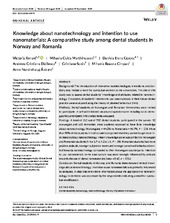| dc.contributor.author | Xenaki, Victoria | en_US |
| dc.contributor.author | Marthinussen, Mihaela Cudia | en_US |
| dc.contributor.author | Costea, Daniela Elena | en_US |
| dc.contributor.author | Didilescu, Andrea | en_US |
| dc.contributor.author | Susin, Cristiano | en_US |
| dc.contributor.author | Cimpan, Mihaela Roxana | en_US |
| dc.contributor.author | Åstrøm, Anne Nordrehaug | en_US |
| dc.date.accessioned | 2020-08-13T07:51:26Z | |
| dc.date.available | 2020-08-13T07:51:26Z | |
| dc.date.issued | 2020 | |
| dc.Published | Xenaki V, Marthinussen MC, Costea DE, Didilescu, Susin C, Cimpan MR, Åstrøm AN. Knowledge about nanotechnology and intention to use nanomaterials: a comparative study among dental students in Norway and Romania. European journal of dental education. 2020;24(1):79-87 | eng |
| dc.identifier.issn | 1396-5883 | |
| dc.identifier.issn | 1600-0579 | |
| dc.identifier.uri | https://hdl.handle.net/1956/23714 | |
| dc.description.abstract | Background: The introduction of innovative nanotechnologies in medicine and dentistry may initiate a need for curriculum revision at the universities. The aim of this study was to assess dental students’ knowledge and attitudes related to nanotechnology. Covariates of students' intention to use nanomaterials in their future dental practice were evaluated using the theory of planned behaviour (TPB). Methods: Dental students at Norwegian and Romanian Universities were invited to participate. A self‐administered structured questionnaire including socio‐demographics and Ajzen's TPB components was used. Findings: A total of 212 out of 732 dental students participated in the survey: 52 Norwegian and 160 Romanian. Most students reported to have little knowledge about nanotechnology (Norwegians = 44.2% vs Romanians = 46.9%, P < .05). More than 90% of the students in both countries reported that they wanted to get more information about nanotechnology. Mean knowledge score was similar for Norwegian and Romanian students (4.4 ± 1.7 vs 4.2 ± 1.4, P > .05). Romanian students had more positive attitude, stronger subjective norms and stronger perceived behavioural control towards nanotechnology compared to their Norwegian counterparts. Intention to use nanomaterials in the total sample was most strongly influenced by attitude towards the use of dental nanomaterials (beta = 0.42, P < .001). Conclusion: Dental students in Norway and Romania demonstrated limited knowledge about nanotechnology. Intention to use nanomaterials was primarily influenced by attitudes. A clear desire for more information about the application of nanotechnology in dentistry was expressed by the respondents indicating a need for curriculum modification. | en_US |
| dc.language.iso | eng | eng |
| dc.publisher | Wiley | eng |
| dc.rights | Attribution CC BY | eng |
| dc.rights.uri | http://creativecommons.org/licenses/by/4.0 | eng |
| dc.title | Knowledge about nanotechnology and intention to use nanomaterials: a comparative study among dental students in Norway and Romania | en_US |
| dc.type | Peer reviewed | |
| dc.type | Journal article | |
| dc.date.updated | 2019-11-11T09:31:37Z | |
| dc.description.version | publishedVersion | en_US |
| dc.rights.holder | Copyright 2019 The Author(s) | |
| dc.identifier.doi | https://doi.org/10.1111/eje.12470 | |
| dc.identifier.cristin | 1736484 | |
| dc.source.journal | European journal of dental education | |

